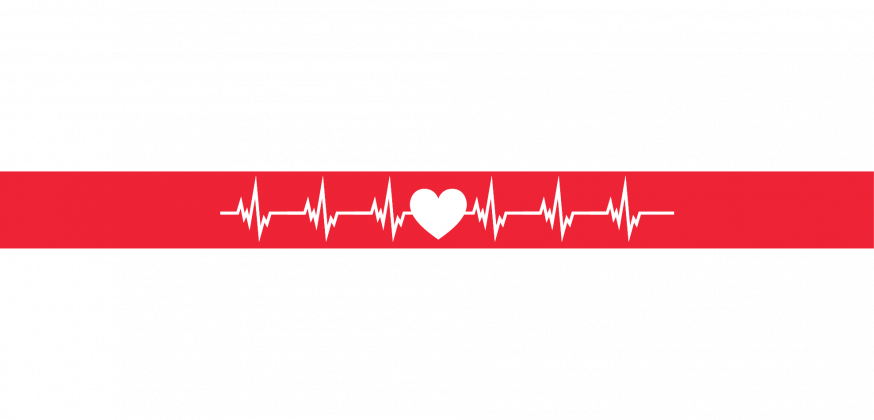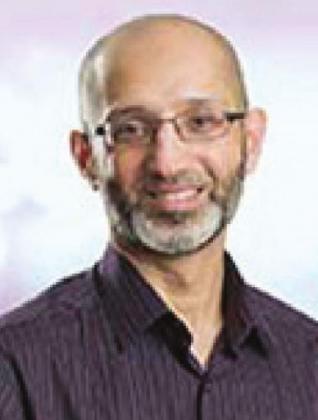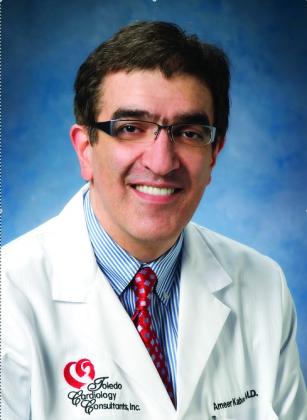MANY AMERICANS may be unaware that they are living with an increased risk for heart disease, yet there are a number of ways both men and women can assess their risk of heart attack and stroke. McLaren St. Luke’s offers various cardiac care and cardiovascular services to help those with heart conditions.
So, what, exactly, should you do to ensure that you are heart healthy to avoid heart attack and stroke? Keep the following in mind:
• Women often present with different heart attack symptoms than men. Traditional (and often male) heart attack symptoms include chest pain and tightness, fatigue, shortness of breath, arm pain, and symptoms that worsen with activity and get better with rest. But oftentimes, women don’t experience many of these more well-known symptoms. Instead, they can experience symptoms of feeling lightheaded, general tiredness, just not feeling right, or not feeling like themselves. They can even get jaw pain. Physicians recommend that if a woman is experiencing any of these symptoms, or she just plain doesn’t feel “right,” she should seek medical attention to rule out cardiovascular disease or other ailments.
• About 80 percent of heart disease and stroke is caused by preventable factors. The major preventable risk factors include high blood pressure, diabetes, smoking or other forms of tobacco use, being overweight and having a more sedentary lifestyle, lack of regular exercise, and consuming high-fat diets.
Owais Khawaja, MD, a cardiologist with McLaren Heart & Vascular, noted that there are ways to prevent heart disease and stroke from happening, such as maintaining a healthy diet, not smoking, controlling cholesterol and blood pressure, and not leaving chronic conditions, such as diabetes, untreated. “These are lifestyle choices that are not exclusive to one particular age group though—it can easily be applied to anyone at any age,” Dr. Khawaja said. “It helps kids and the younger generations create good heart habits they can take into their later years, and it can help the older generations optimize their current heart and brain health.”
Family history also plays an important role
“If someone does have a significant family history of heart disease or stroke, they should come to their doctor much earlier,” Dr. Khawaja said. “In their 30s, they need to start really paying more attention to any heart and stroke symptoms and their lifestyle.”
With regard to both heart attack and stroke, the bottom line, according to Dr. Khawaja, is to take note of how you are feeling and follow up with your physician if anything feels “off.” Secondly, both heart disease and stroke can be prevented by following many of the same healthy lifestyle regimes: eating a healthy diet, exercising regularly, monitoring blood pressure and cholesterol, monitoring diabetic symptoms, and avoiding alcohol and smoking.
“There is a lot a patient can do to reduce his or her risk for heart disease and stroke,” said Dr. Khawaja. “Always listen to your body.”
The American Heart Association and the American Stroke Association recently recognized McLaren St. Luke’s with two awards for its continued success in using the “Get with the Guidelines – Stroke, Target: Stroke” and “Target: Type 2 Diabetes” programs. For their efforts, McLaren St. Luke’s received the Gold Plus awards in the stroke and type 2 diabetes categories.
“We are proud of our staff who work so hard to provide cardiac care to patients with symptoms that could lead to heart attack, stroke, or other coronary disease,” said Jennifer Montgomery, President and CEO of McLaren St. Luke’s. “Earning these awards is voluntary, and the efforts to seek such achievements are a testament to the dedication we have to enhancing quality care for our patients.”
Women: don’t ignore these potential heart attack symptoms
IF YOU THINK A HEART ATTACK is always signaled by crushing chest pain and that heart disease is primarily a problem for men but not women, you need to think again. While some degree of chest pain or discomfort is the most common symptom of heart attack, it’s not unusual for very different symptoms to manifest themselves during a heart attack, particularly among women. With respect to men being more vulnerable to heart disease than women, that’s a myth, too. In fact, heart disease is the number-one killer of both men and women.
“Typical” symptoms of heart attack may include (but aren’t limited to) pain, discomfort, pressure, or squeezing in the chest; pain radiating down the inside of the arm (usually, but not always, the left arm); pain in the upper body, such as above the upper back, in the jaw, or in the neck; shortness of breath; lightheadedness; nausea and vomiting; abdominal pain or heartburn; sweating; and anxiety. Both men and women can experience any of these symptoms during a heart attack, but symptoms unrelated to chest pain are more likely to occur in women than in men during a heart attack.
Because the “characteristic” chest pain is often absent and many of these symptoms are subtle and can be attributed to other common ailments, such as the flu, gastrointestinal issues, or arthritis pain, women commonly delay seeking medical help for heart attack until after significant damage has already been done to the heart muscle. What’s more, once they do seek medical help, it’s all too easy for doctors to misdiagnose the problem because many are conditioned to view crushing chest pain as the hallmark symptom of heart attack.
Interestingly, many women who have had a heart attack report having experienced warning signs as early as a month or more before the actual event—though they may not have recognized them for what they were at the time. NIH research shows that the most common early warning signs of heart attack among women are unusual fatigue, sleep disturbance, and shortness of breath.
Another factor that often contributes to women ignoring potential heart attack symptoms or delaying seeking treatment is the tendency of women to assume the role of family caregiver. Women commonly put the needs of children, spouses, elderly parents, and other loved ones ahead of their own and, so, feel awkward or embarrassed about drawing attention to themselves or putting their needs ahead of others—even when it comes to major health concerns. Also, since women’s heart attack symptoms or early warning signs tend to be more subtle, they may wait to see if they resolve on their own or try remedies for other ailments, such as indigestion or arthritis pain, before seeking help.
A heart attack occurs when waxy plaques block the flow of oxygen-rich blood to the heart muscle. If the blockage isn’t relieved promptly, the heart muscle tissue that is supplied by the blocked artery will soon begin to die. The more time that is lost in seeking emergency medical care for a heart attack, the more heart tissue is lost. Hence, it’s critical for both women and men to be aware of their heart attack risk and educate themselves on the wide range of symptoms that heart attacks can cause.
According to the NIH, risk factors for heart attack include a family history of heart disease, age, stress, unhealthy diet, smoking, being overweight or obese, diabetes or pre-diabetes, high blood pressure, high triglycerides, and high cholesterol. It’s important to discuss your risk factors with your doctor. Some can be controlled through appropriate lifestyle changes—exercise, proper diet, smoking cessation, etc.—while others might be manageable with proper medical treatment.
If you think you’re having a heart attack, call 911 without delay. Don’t attempt to drive yourself or have a friend drive you to the emergency room. Emergency medical technicians will be able to initiate medical treatment as soon as they arrive on the scene as well as en route to the ER, which can buy your heart valuable time. They’ll also get you to the hospital—and advanced care—as quickly and safely as possible. Most important, don’t let concern about a potential false alarm dissuade you from seeking prompt emergency medical care if you suspect you’re having a heart attack. When it comes to the number-one killer of both men and women, it’s better to be safe than sorry.
Rhythm with music is theme of women’s heart health month
by Dennis Bova
The pandemic has upended many daily routines, including those pertaining to health. The American Heart Association is painfully aware of this, especially during February, which the national nonprofit sets aside as American Heart Month that features its Go Red for Women campaign.
Go Red for Women is AHA’s way to raise awareness of heart disease and stroke among women. The public thinks heart disease—the number one killer of Americans—primarily strikes older men, but more women than men are affected by it.
This year, the campaign theme is Reclaim Your Rhythm, which aims to get its message across through music.
“Having this theme is necessary,” says Elizabeth Lewis, director of social events for the American Heart Association of Northwest Ohio. She says people need to lift themselves from the doldrums of despair that many fell into during ongoing COVID-19 restrictions. In essence, people should strive to reclaim their pre-pandemic rhythm.
“At the American Heart Association, we’ve talked about physical health,” Lewis adds, “but we’re starting to talk about mental health a lot more, especially since the pandemic started. People are experiencing lower physical health and emotional awareness. “
“Heart disease deaths rose significantly last year. We want to encourage women to take charge of their health and get back on track, or if they’ve never been on track, give them
the opportunity to do so.”
Lewis says, “Music is the universal language. It brings good vibes.” So, the five elements of Reclaim Your Rhythm have a music theme:
Mellow out and reduce stress. “Stress leads to unhealthy habits,” she says. “We want people to take a breather.”
Move to the music. “Physical activity is linked to lower risk of heart disease and improved mental health,” she says. It doesn’t matter what kind of music is playing, either through a device or in your mind. “Just get up and move.”
Feed your soul and rock your recipes. “Eating has a huge impact on health. Make sure you eat nutritious meals. Eat with family and friends to decompress and reconnect with each other. This can reduce stress and improve self-esteem,” she says.
Stay on the beat with blood pressure. Lewis states, “About half of all Americans have high blood pressure, which is a leading cause of heart disease. We want to make sure people go to their doctor regularly and get their blood pressure checked. And to take their medication. Going back to eating, blood pressure can be controlled through food, such as reducing sodium.”
Keep the beat by learning hands-only CPR. In this form of cardio-pulmonary resuscitation, only chest compressions are given, not blowing air into the victim through mouth-to-mouth. “The aim is for 100 to 120 compressions per minute.” With another nod to music, Lewis adds, “Ironically, the Bee Gees’ ‘Stayin’ Alive’ is the beat people need to keep up with. We use that in our training. It’s a fun thing, and people don’t forget it.”
Lewis says the AHA hopes people embrace these components throughout February, including two signature events. The first Friday in February, this year February 4, is Wear Red Day, when women—and men—are encouraged to wear red to spur conversations about heart health. Red runs through the campaign because that color is associated with the heart.
The other event usually is later in the month but this year will be Thursday, March 3, the Go Red for Women luncheon at The Premier in Toledo. Lewis says the luncheon was pushed back to March to give more time for any potential virus spike to lessen.
“The luncheon will be in person, and because we’re a health organization, we have tight protocols to follow. Everyone will have to wear a mask, vaccinated or unvaccinated, except at the table when eating or drinking,” she says.
Doors will open at 11:00 with a health expo featuring event sponsors and vendors. Lunch will be at noon, with inspirational guest speaker Dr. Karen Townsend from Dayton. It’ll be over at 1:00. “It’s a short-and-sweet event, but also impactful for our guests,” Lewis says.
For more information or to reserve a spot, contact Lewis at Elizabeth.Lewis@Heart.org or 419-740-9666.
“It’s been a tough two years,” Lewis says of living through the pandemic. “We’re not all in the same boat, but we’re in the same storm. As women, we need to take care of ourselves. If we can’t do that, we can’t take care of others.”
Dennis Bova is a freelance writer and editor.
Innovative technology offers heart-failure patients hope for improved quality of life
HEART FAILURE IS a chronic, progressive disease that, according to the Heart Failure Society of America (HFSA), affects approximately 6.5 million Americans over the age of 20 and contributes to an estimated 36% of all cardiovascular disease deaths in the US.
Cardiologist Ameer Kabour, MD, explains that heart failure does not mean the heart has stopped beating. Rather, it means the heart muscle has weakened to the point that it can no longer pump enough oxygen-rich blood to the body and the rest of the organs. The symptoms of this condition, which commonly include shortness of breath, fatigue, and the reduced ability to engage in activity and exercise, can eventually become severely debilitating.
According to the Centers for Disease Control and Prevention, several factors can cause or contribute to heart failure, including coronary artery disease, diabetes, high blood pressure, obesity, other conditions related to heart disease, valvular heart disease, as well as certain unhealthy lifestyle habits such as smoking, improper diet, lack of adequate physical activity, and excessive alcohol consumption.
Anita Kirian, age 60, knows all too well how heart failure can gradually reduce one’s quality of life. Anita suffered a major heart attack at age 35 that significantly impaired her heart function. Following the heart attack, she had two stents implanted, and she has since gone through three pacemakers due to the ongoing decline of her heart function.
The “seeds” for heart disease were planted relatively early in life for Anita. By age 19, she was already having problems with her cholesterol and triglyceride levels and she was officially diagnosed with high blood pressure. In terms of family history, one could say she gets it from both sides—her father experienced a major heart attack, and her mother has high cholesterol and triglycerides as well.
Anita recognizes that her dietary habits were a major contributing factor, and she urges others to be cognizant of the impact lifestyle choices can have on heart health, especially in those with a strong family history of heart disease. “When you’re 19 and everyone around you seems to be eating whatever they want, who wants to worry about pizza and Coke? But you can’t think that way. You can’t take for granted that your body will always bounce back because it eventually won’t. If you have a family history of heart problems, you can’t ignore the signs and think you’re too young to be concerned. You’d better keep an eye on those numbers and watch what you eat!” she cautions.
As her symptoms became more severe, Anita found herself struggling more and more with everyday activities. “Everything was getting worse,” she recalls. “My energy just wasn’t there anymore. After coming up to my apartment, my legs would hurt so much that I had to bend over and rub my thighs. Also, I love gardening, but I found I no longer had the energy for it. I just bought a new shovel, but I couldn’t dig a hole to get my perennials in the ground. So, I just sat there on my little chair in the garden and started crying.”
What Anita found particularly frustrating was the sense that she was beginning to lose control. “I’ve always been in control of myself,” she says. “Even with heart disease, I was able to work and function more or less normally as long as I was aware of my limitations. But that was all slipping away.” Adding insult to injury, she has developed several other underlying conditions that often go hand in hand with heart disease, including kidney disease and fatty liver disease, and she has experienced several episodes of pancreatitis.
The good news is, Anita’s journey recently took a more positive turn when she underwent a new, FDA-approved, minimally invasive therapy for heart failure called cardiac contractility modulation, or CCMTM, at Mercy Health – St. Vincent Medical Center. CCM, using the state-of-the-art Optimizer® system, is a breakthrough therapy that delivers precisely timed electrical pulses to the heart with the intention of improving its ability to contract, thereby allowing more oxygen-rich blood to reach the body.
Mercy Health has become a leader in the region in performing CCMTM.
Dr. Kabour has performed more than 4 CCM therapy implants at Mercy Health – St. Vincent Medical Center since the procedure first became available late last year.
The best candidates for CCM therapy are patients who have an ejection fraction (a measurement of the percentage of blood that leaves the heart with each contraction) of 25% to 45% (normal is 50% to 65%), are symptomatic, and are unable to manage their symptoms or slow the progression of their heart failure with other treatments.
Dr. Kabour, who performed Anita’s CCM procedure on November 30, 2021, remarks, “The Optimizer device, which is very similar to a pacemaker, is implanted under the skin of the upper chest under local anesthesia, and two leads are placed in the right ventricle in the septal area of the heart. The leads deliver electrical signals between them, which moves the septum in a better-coordinated way so the patient becomes less symptomatic. The whole implantation takes only about 30 to 45 minutes if everything goes smoothly.”
It’s important to understand that CCM is not a cure for heart failure. “The goal of this therapy is for patients to have improved symptoms and a better quality of life. Following the procedure, we’re seeing significant improvement in patients’ oxygen level with exercise, symptom severity, and rate of hospitalization. The improvement is gradual, however. While there have been some patients who felt dramatically better in a few days, our expectation is to see improvement within a few weeks of surgery,” Dr. Kabour says.
Since undergoing CCM, Anita reports that she feels somewhat better, but she has been in and out of the hospital with pancreatitis flare-ups. Her hope is that with her now-improved blood flow, her heart and other organs will stabilize and begin to repair themselves where possible, allowing her to avoid the need for dialysis or transplant. She also acknowledges that any improvements she experiences will be gradual, stating, “As a society, we expect miracles, but it took a while to get to this point, so it might take a long time to start feeling better.”
Above all, Anita is optimistic about her prospects for returning to her favorite pastime. “Hopefully, come spring, I’ll be back in the yard and garden again, putzing around and making a mess,” she says.






